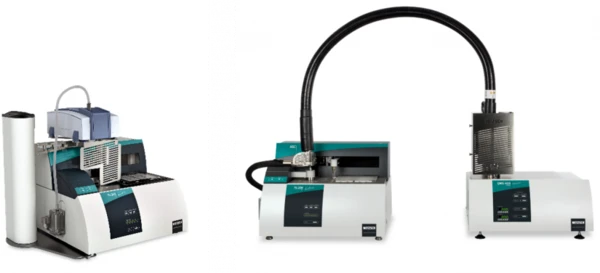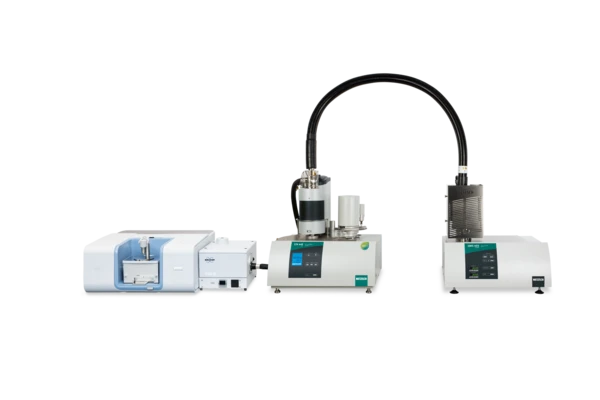
26.08.2021 by Aileen Sammler
1+1=3: Combination of Evolved Gas Analysis and Thermal Analysis
In the field of Thermal Analysis, coupling is typically used to characterize the chemical components of the gases released during heating, an approach called Evolved Gas Analysis (EGA). Learn how to gain a deeper insight about the type and composition of your materials by means of EGA.
The majority of today’s thermoanalytic methods belongs to the group of descriptive analysis. That means these methods are capable to allow for precise characterization of the thermal behavior of a material. For instance, they can answer questions like:
- When does a material melt?
- At what temperature does the Decomposition reactionA decomposition reaction is a thermally induced reaction of a chemical compound forming solid and/or gaseous products. decomposition of the material start?
- How will the size of a part change during temperature treatment?
However, thermal analysis often cannot answer directly “Why something happens”. Thermal analysis provides no direct identification of what happens to the material. It just describes the process itself like melting or mass loss of a material. In many cases, conventional thermoanalytical methods are not sufficient to gain a better understanding of a material and its thermal behavior. Therefore, thermal analytic methods are frequently combined with further analytic techniques. This is called hyphenation combining two or more analytical methods to enhance material characterization.
Evolved Gas Analysis – Learn more about your materials
In the field of Thermal Analysis, coupling is typically used to characterize the chemical components of the gases released during heating, an approach called Evolved Gas Analysis (EGA). By means of EGA, you gain a deeper insight about the type and composition of the materials. Common instrument combinations like thermal analyzers with FT-IR (Fourier Transform Infrared Spectrometers), MS (Mass Spectrometers) and GC-MS (Gas Chromatograph with a mass spectrometer as detector) provide crucial information regarding nature or amount, or both of gases and vapors evolved during thermal treatment. This makes coupling solutions a perfect tool to better understand processes, prevent safety risks and investigate the Thermal StabilityA material is thermally stable if it does not decompose under the influence of temperature. One way to determine the thermal stability of a substance is to use a TGA (thermogravimetric analyzer). thermal stability of materials. EGA therefore offers numerous options to answer questions in the polymer, inorganic and pharmaceutical fields.

Connecting TGA to a Mass Spectrometer (TG-MS) or Fourier Transform Infrared Spectrometer (TG-FTIR) is a common example for a combination of thermal analysis and evolved gas analysis. These coupling techniques allow for a simultaneous study of the mass change behavior and an identification of the chemical components that are released from the material during heating. They can be used to investigate a broad variety of materials such as polymers, organics, inorganics, ceramics and many more.
For demanding applications such as the Decomposition reactionA decomposition reaction is a thermally induced reaction of a chemical compound forming solid and/or gaseous products. decomposition of complex organic materials or even biomasses, advanced coupling solutions are possible. This can be realized by the coupling of a Gas Chromatograph with Mass Spectrometry (GC-MS) or even the simultaneous coupling of two spectroscopic techniques like TGA-MS-FTIR.


For special application cases, NETZSCH offers a completely integrated coupling solution with the MS-Skimmer. This particular approach integrates coupling technology with a mass spectrometer directly into the design of a simultaneous thermal analyzer (STA) furnace.
By this integration, transfer temperatures – depending on the furnace type – up to 1950°C are realizable. This offers the possibility to investigate also such gases that condense easily, e.g., from materials like metals, ceramics and inorganics.
Watch our Webinar for further information: Next Generation of Evolved Gas Analysis on Vimeo:
Leading in Evolved Gas Analysis
NETZSCH has a development experience of nearly half a century in the field of Evolved Gas Analysis and coupling technologies providing solutions for material research and development for all kinds of industrial and academic applications. Please find out more about our EGA methods here: Hyphenated Techniques – Evolved Gas Analysis (EGA) – NETZSCH Analyzing & Testing (NETZSCH-thermal-analysis.com)